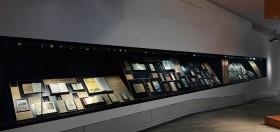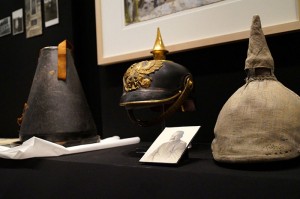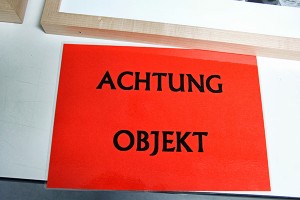
View of the cabinet exhibition “In a foreign country. Publications from the Displaced Persons Camps” in the basement of the Libeskind Building.
© Jewish Museum Berlin, photo: Jens Ziehe
In our cabinet exhibition “In a foreign country” we explore the publishing operations of survivors and refugees, the so-called displaced persons (DPs) who were stranded in occupied Germany after 1945. For this show we selected the widest variety of genres: schoolbooks, Judaica, volumes of poetry and prose, historical documentation, and Zionist pamphlets.
They all have two things in common: first, the quality of the paper these post-war printers used was extremely bad. Second, they all come from the Berlin State Library, whom we’re hosting for this exhibition due to its historically valuable collection of DP literature.
With one little exception. → continue reading
Or: How 300 Artifacts from our Collection Were Turned into a Cabinet Exhibition about the First World War

Objects from our collections in the exhibition “The First World War in Jewish Memory”
© Jewish Museum Berlin, photo: Mariette Franz
Our exhibition “The First World War in Jewish Memory” opened last week. It is based primarily on collections donated to the Jewish Museum by German-Jewish families and each exhibit tells a very personal story.
In total, 176 exhibits were selected, researched and arranged as a visual narrative by eight curators, six restorers, two exhibition technicians, a translator and a graphic artist. So, even before I mention our numerous willing helpers in the wings, in particular the student assistants and the Museum caretaker, this sounds like a big team for a big exhibition. In fact, our joint endeavor culminated in a small cabinet exhibition relating to the First World War, which can be viewed until 16 November in the Rafael Roth Learning Center. → continue reading

A label in our restoration studio to prevent anyone from inadvertently touching or removing an object.
© Jewish Museum Berlin, photo: Gelia Eisert
My story actually begins with a visit to the museum. It draws the curtain slightly on the making of an exhibit that’s usually veiled from the eyes of visitors. But first I have to tell another story, in order for both – one current and one from the past – to have meaning.
A little trail runs through our permanent exhibition pointing to David Friedländer (1750-1834). → continue reading


